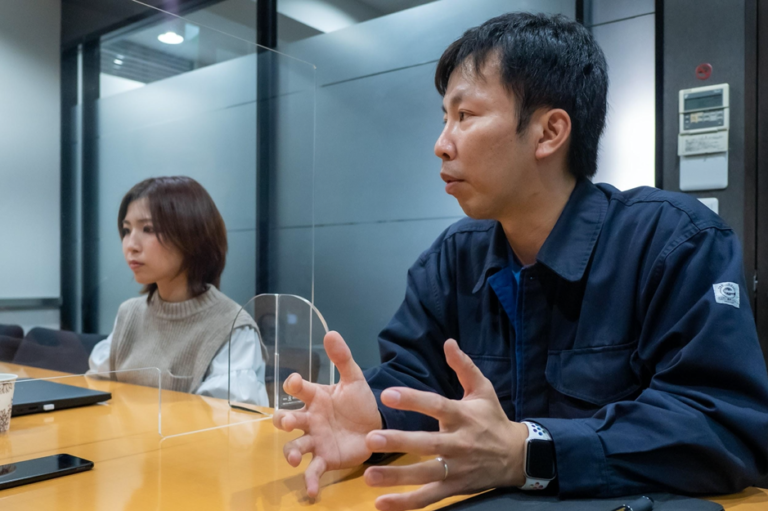In this article, discover 3 ways to use 360° technology to streamline your projects, ensure comprehensive documentation, and increase your efficiency.
1. Integrating 360° into BIM
Tracking the progress of a construction site in real-time can be complex and time-consuming, which may lead to errors and delays. 360° images offer the ability to monitor the progress of the work in real-time and compare the BIM model with reality. A 360° panorama can replace hundreds of 2D photos, greatly simplifying documentation.
Software like Dalux, PlanRadar, and Cupix allows you to overlay 360° images onto the BIM model to identify discrepancies. For example, you can compare a 360° photo of a room with the actual state of secondary works, such as plumbing, heating, and ventilation, to verify compliance and detect discrepancies. An interesting aspect of this documentation is capturing hidden elements like pipes, electrical cables, and ventilation ducts before the walls are covered. Once these elements are hidden, they are only accessible through technical drawings. By documenting these construction phases, you ensure you have precise and usable visual records in BIM for future reference.

BIM Cupix model
This technology reduces errors, improves accuracy, and facilitates collaboration. The entire team can view 360° images, whether they are on-site or remote. Use high-performance 360° cameras like Ricoh's, which offer exceptional image quality and easy integration thanks to their APIs.
Benefits:
- Time savings: A 360° panorama replaces hundreds of 2D photos, reducing documentation time and allowing for better resource allocation.
- Error reduction: Overlaying 360° images onto the BIM model ensures accurate real-world modeling.
- Effective collaboration: 360° images can be shared and viewed by the entire team, even remotely, improving communication and collective decision-making.
2. End-to-End Documentation: From Site Monitoring to Delivery
Site monitoring documentation ensures precise control of each stage of the project. By capturing 360° still images or using "SiteWalk" videos, you can create a comprehensive and detailed visual history. This process allows for compliance checks while providing tangible evidence to share with stakeholders, without the need to travel. Thus, teams, whether on-site or remote, can follow the progress in real-time, saving time and optimizing coordination.
The SiteWalk and Side by Side features are essential for optimized site management. SiteWalk allows you to capture the project's progress by creating a real-time visual timeline from 360° images, with the ability to view captured images at any key stage. Side by Side makes it easy to compare two phases of the site, improving discrepancy detection and coordination. These features can be directly integrated into your internal software, enhancing your efficiency.
Several companies offer these features that integrate seamlessly into your existing tools, such as Disperse, which uses these solutions to improve site management while directly integrating Ricoh cameras to maximize image quality and ease of use.
.png)
Side-by-side Disperse
Finally, the final documentation at delivery is essential to ensure that all specifications have been met. Capturing 360° images of the finished building ensures a complete inspection and creates a detailed visual file. This file will serve as a reference for future audits and maintenance interventions, ensuring total compliance and facilitating post-delivery management.
Benefits of 360° Documentation:
- Control and compliance: Precise monitoring and verification of each construction stage, ensuring all specifications are met.
- Proof and accountability: Detailed visual history to justify progress and meet stakeholder requirements.
- Time savings: Remote monitoring and reduced on-site inspections.
- Post-delivery support: Complete visual record for audits and future maintenance.
3. Efficient Building Management and Maintenance with 360°
Maintaining and managing a building effectively can be complex, especially when monitoring the condition of installations and quickly detecting anomalies. 360° technology facilitates these tasks in several ways.
Building plans can be created using Ricoh 360° cameras, which are easy to use for measuring and generating plans. Platforms like Matterport or Floorfy allow for the creation of detailed and accurate 3D plans. These tools capture the entire building with precision, offering a complete view of the infrastructure. This approach makes remote monitoring easier and allows for realistic building visualization.

Matterport 3D Plan
As described in previous stages, documenting and capturing hidden elements, such as pipes and electrical cables before the walls are covered, is crucial for future maintenance. These images are the only way to know the exact location of installations once the walls are closed. They become an invaluable resource for years to come, serving as a reference for regular maintenance and in case of an incident.
Once the project is delivered, the final 360° capture of the finished building also plays a crucial role. For example, if a radiator breaks down after delivery, these post-delivery images help quickly locate the fault thanks to the precise documentation of ducts and wiring. You can also annotate directly on the 360° view to indicate the location of the problem. These annotations are then shared with technical teams, allowing for faster and more efficient intervention. Ricoh 360° cameras, with their image quality and compatibility with building management systems, facilitate these interventions and ensure proactive management of hidden infrastructures.
Benefits:
- Creation of detailed 3D plans: 360° cameras, combined with platforms like Matterport or Floorfy, allow for the creation of precise 3D plans, with the ability to take measurements directly on the plans, simplifying infrastructure monitoring and management.
- Quick detection and efficient intervention: 360° panoramas and 3D plans enable rapid anomaly detection, while annotations on 360° views facilitate targeted and swift technical team interventions.
- Optimized maintenance: The visual documentation of hidden installations, captured before the walls are closed, serves as a long-term reference for future maintenance, enabling proactive management and reducing unnecessary travel
Conclusion
Adopt 360° technology and integrated software throughout all construction phases to save time, improve accuracy, reduce errors, optimize collaboration, and ensure comprehensive documentation. To maximize the efficiency of your projects, integrate these tools today. Explore our resources to see concrete examples of using 360° cameras in the construction industry.




.jpg)


.svg)




